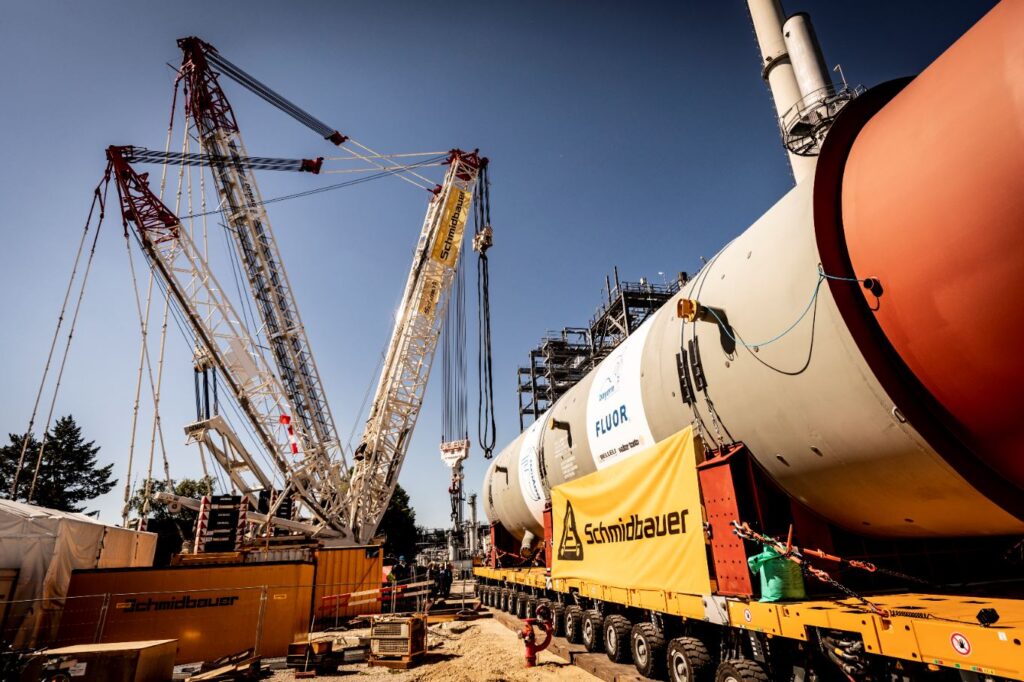Gigantic total weight transported
5th August 2021

On behalf of BayernOil, Schmidbauer transported two huge reactors from Kelheim to Neustadt a. d. Donau in just four stages. Despite adverse weather conditions, hundreds followed how the specialist for heavy loads mastered the complex task.
The task was: 336 tires and up to 880 tons total weight each – never before has a greater weight been transported on the road in Germany. No wonder that the entire route was lined with onlookers – and even competitors curiously accompanied each of the trips. 660 tons and 600 tons respectively are the weight of the two new reactors that Schmidbauer transported from the port of Kelheim to Neustadt a. d. Donau. In the oil refinery of BayernOil Raffineriegesellschaft mbH, the reactors, each with a volume of 400 m³, will now enable the throughput of heavy gas oils to be increased to 300 tons/hour as part of the mild hydrocracker plant. They are needed to produce sulphur-free diesel fuel.
Even the lift at the beginning and end of the project was an impressive feat: there are currently only 51 machines of the corresponding design in the world that can manage it: Schmidbauer had used a Tadano CC 8800-1 crawler crane for the lifting work, which mastered the transhipment and handling in the port of Kelheim as well as the assembly of the reactors in the refinery. In between, there were only a few days for the assembly and disassembly of the crane and its transport, a real challenge for the whole team. The huge reactors were then moved by two self-propelled modular transporters (SPMTs), each with 2 x 22 axles and 176 tires. Only such special transporters can carry such immense axle loads. The maximum dimensions of the individual columns were 37 meters long, 8.2 meters high and 6.6 meters wide.
“Such huge dimensions can quickly become a problem, because neither the roads in Germany nor the rest of the infrastructure are designed for these dimensions,” explains Stefan Schmidbauer, Managing Director of the Schmidbauer Group and project manager for the transport. “Especially bridge crossings, but also railway crossings are special problems that we have to pay special attention to.”
Reaching the goal in just four stages
Only four stages were planned for the route in order to keep traffic restrictions as low as possible. It was not only the fast execution and the short preparation time of only six months that posed a real challenge: The route, although only 30 km long, led in part through very narrow villages and over several bridges, and there were also considerable inclines to overcome.
Each stage had its own challenges in store: The start in Kelheim was accompanied by thunderstorm-like downpours, but fortunately this only led to minor time delays. The Weltenburger Berg on the second stage, with its steep incline of up to 8 degrees, was considered to be one of the most difficult obstacles, which could have caused considerable problems with traction if the bad weather conditions had continued to threaten. But the weather cooperated and the transport over the mountain went almost smoothly.
Then, on the third leg to Bad Gögging, an additional structure with 22 hydraulic presses to secure the statics had to be used when crossing a bridge to ensure safe passage. On the final stretch to Neustadt a. d. Donau, there was also time pressure: For the crossing of a railroad crossing at 3 a.m., only a minimal time window of 4 hours was available to cover the railroad crossing with gravel and roadway plates, to successfully drive over it and to release it again for Deutsche Bahn.
The entire project required extensive feasibility studies in advance, geotechnical reports, and engineering services for stability, as well as structural analysis for the necessary structure overpasses and road analyses including soil compression. Countless traffic signs, street lighting, telephone lines, curves, inclines, construction sites, bridges, side slopes, intersections and traffic circles had to be considered. In addition, various temporary roads were built to avoid critical route points such as railroad crossings and bridge crossings. “The contract was not awarded until December 2020. Implementing all these steps by the time of transport at the beginning of June was a real challenge, but one that we were happy to accept,” adds Stefan Schmidbauer.
Of course, every single section was a real spectacle for the spectators. That is why each transport was manned by eight people, driving personnel, project escorts as well as security. Their task was, among other things, to keep the numerous onlookers from getting too close to the vehicles and the heavy load at any time, thus ensuring the safety of the transport, as well as to accompany the SPMTs around the clock and ensure that everything went smoothly.
At the destination, the CC 8800-1 was ready again to be used for lifting the reactors, and a CC 2800-1 as a tracking crane. With a lifting capacity of 1,600 tons and a total of 900 tons of ballast, it carried out what was probably Germany’s heaviest single lift at 700 tons with a radius of 26 meters. “The fact that we managed to do all this and complete the high-performance transport so smoothly and quickly thrills the whole team. We are very proud and hope to set an even bigger record soon. A big thank you to everyone who helped with this extraordinary project!” says a delighted Stefan Schmidbauer.

